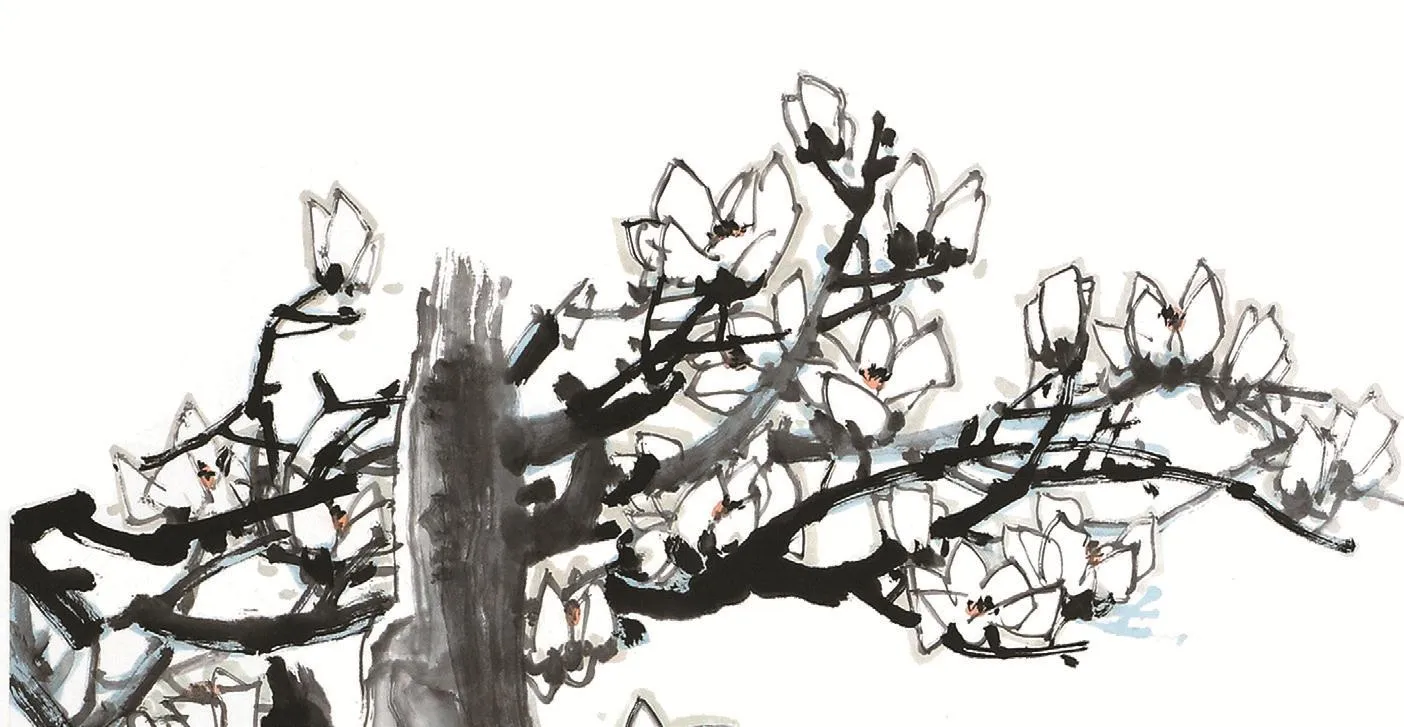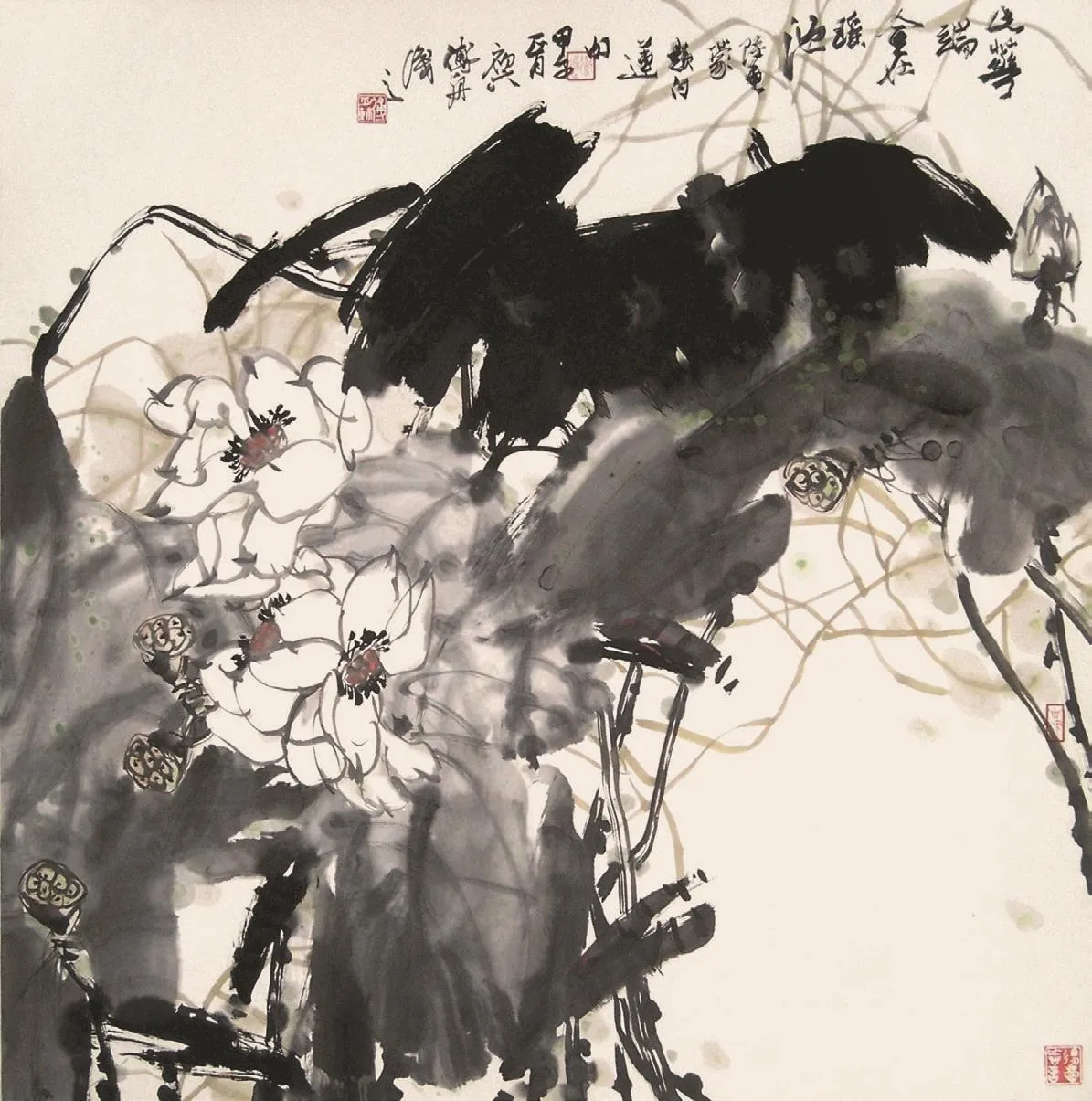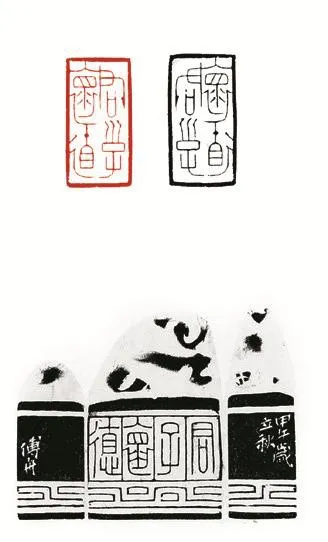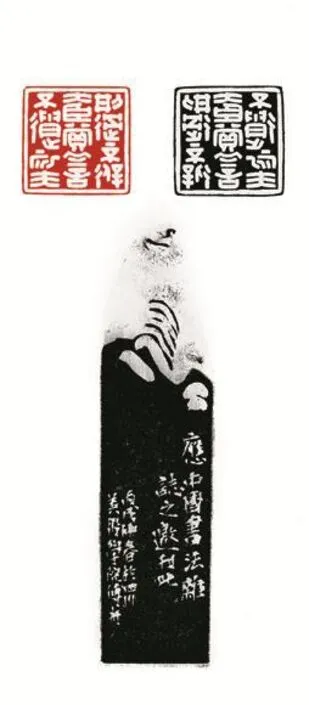傅舟:刀笔下的人生
◇ 文| 本刊记者 陈科龙 实习生 朱江怡 图| 刘一周 受访者提供
傅舟:刀笔下的人生
◇ 文| 本刊记者 陈科龙 实习生 朱江怡 图| 刘一周 受访者提供

上世纪70年代初,年幼的傅舟跟着父母随西南师范学院(现西南大学)迁往忠县。约摸11岁时,傅舟的物理老师陈老师见他字写得不赖,便将一本用报纸包裹得严严实实的字帖送给他,要他勤奋临摹字帖。
回到家后,傅舟小心翼翼地剥开一层层报纸,打开一看是《曹全碑》。那个暑假,整整40天,傅舟都在临摹《曹全碑》字帖,由此开始了他与诗书画印的不解之缘。
In the early 1970s, young Fu Zhou and his parents moved to Zhong County with Southwest Normal University (now Southwest University).At the age of about 11, Fu Zhou’s physics teacher Chen saw his handwriting, gave him a copybook tightly wrapped upwith newspaper,and encouraged him to work hard to practice calligraphy.
When getting home, Fu Zhou peeled off the layers of the newspaper and found it a copybook of Cao Quan Stele.That summer vacation, forty days long, he was always copying Cao Quan Stele, which developed an indissoluble bond between him and poetry, calligraphy, painting and seal cutting.
转益多师是吾师
Great Achievements Come from Great Teachers
1973年,西南师范学院搬回北碚,傅舟开始跟着美术系的郭克、苏葆桢、方凤富等老师学习花鸟画。1977年,高考恢复后,傅舟一心想考入美术系继续学习绘画,但却4次折戟。直到1979年,第五次高考才终于考上了西南师范学院中文系。
这一境遇不仅没有成为傅舟的遗憾,相反,正是由于在西师中文系求学,他才有机会受教于徐无闻和秦效侃两位老师。
“渴不饮盗泉水,热不息恶木阴。”1980年跟随徐无闻先生学习书法、篆刻的傅舟,对徐老师的这一枚印章,记忆尤为深刻,它彰显了徐老师“清刚”的性格。徐老师不仅是位全才,精通书法、篆刻、绘画,在文字学、诗词学、金石学等领域都是行家里手,而且对学问要求极为严苛,人品学养俱佳。傅舟耳濡目染,深受影响。
面对今天在书画印上取得的成就,傅舟坦言,离不开徐老师的教诲,敦促自己在中国古典文学上打下了的扎实基础,“就诗书画印而言,‘诗’排在第一位,是内在的根底,是深沉的学养。而书法则处在第二层,书法的笔法、线条等艺术元素都深刻地影响着绘画和篆刻。”
In 1973, when Southwest Normal University Moved back to Beibei, Fu Zhou started to learn paintings of flowers and birds in traditional Chinese style from Guo Ke, Su Baozhen, Fang Fengfu and other teachers.In 1977, after Gaokao was reinstated,Fu Zhou was bent on being admitted to department of Fine Arts to continue to learn drawing but he failed four times.Until 1979, he was admitted to department of Chinese language and literature in Southwest Normal University.
The outcome was not a regret for Fu, on the contrary, was bliss.Thanks to studying in department of Chinese language and literature in Southwest Normal University, Fu had a chance to be taught by Xu Wuwen and Qin Xiaokan.
In 1980, Fu followed Mr.Xu to learn calligraphy and seal cutting.He was impressed by Mr.Xu’s seal with “thirsty but do not drink polluted water, hot but do not rest under evil trees” on it,which showed his character of having an iron fist in a velvet glove.As an expert in calligraphy, seal cutting, drawing, philology, poetry studies and epigraphy, Mr.Xu can be called an all-rounder,but his requirements for learning were extremely demanding, which has a big influence on Fu Zhou.
In the face of today’s achievements in calligraphy, painting and seal cutting, Fu Zhou admitted that Mr.Xu’s teachings helped him lay a solid foundation in Chinese classical literature.Poetry,ranking first among poetry, calligraphy, painting and seal cutting, is an innate quality and deep knowledge.Calligraphy comes to the second place and its artistic elements, like brushwork and lines, all have strong influence on painting and seal cutting.
刀尖上的艺术
The Art on the Tip of Carving Knives
傅舟幼年习字,青年学画,进入大学后才开始真正钻研篆刻这一艺术形式。比起书法绘画,他在篆刻上却是最先有所成就。原来,在一次和徐老师的闲谈中,徐老师对傅舟和张一农说:“成渝两地跟我学书法篆刻者有十数人,书法取得成就的不少,但篆刻尚无一人。”于是,有意无意间,傅舟在篆刻上下了更多功夫。
且不说夏日酷热中的赤膊奋战,也不说凛冬深夜的挑灯弄刀,单看几方印章的边款时间是除夕之夜,就可一瞥其心力。近年来,即使教学和行政事务增加,傅舟依旧会挤出时间,到工作室习字读书、刀削錾刻。
傅舟在每一方印作的选字、布局、刀法等方面都有一套熟练的技巧。然而,正如傅舟所意识到的那样,“技进乎道”才是艺术的目的。因此,不仅在篆刻技法方面,他能融会贯通诸种技法,在各门类艺术间,他也找到了贯通之法。如将小篆书写与朱文印打通,印证了邓石如所实践、魏稼孙所归纳的“印从书出”的理论。

瑶池仙子 68x68cm 2014年
Fu Zhou learned calligraphy during his infancy and learned painting when he was young.He did not really begin to dig into seal cutting until he went to college.Compared with calligraphy and painting, his seal cutting was first to give him rewards.This was because Mr.Xu once told him and Zhang Yinong that more than ten people from Chengdu and Chongqing learned calligraphy and seal cutting from Mr.Xu and many of them made achievement on calligraphy, but none on seal cutting.After this talk, Fu Zhou worked harder on seal cutting.
Some seals’ edge time being New Year’s Eve gave a glimpse of Fu Zhou’s hard work on seal cutting, let alone studying in the summer’s heat and in the late nights’ winter winds.In recent years,Fu Zhou still squeezed out extra time to practice calligraphy, read books and carve seals even though teaching and administrative affairs increased.
Fu Zhou has a proficient skill in choosing characters, layout and way of cutting of every seal.As Fu Zhou realized, however,“advanced by Tao”is the purpose of art.As a result, Fu Zhou can not only integrate many seal cutting techniques, but also has achieved mastery through a comprehensivestudy between various kinds of art.For instance, he combined small seal script and red legend seal and proved the theory “seal out of calligraphy” practiced by Deng Shiru and summed up by Wei Jiasun.

滕王阁序 纸本水墨 270x34cm 2014年长卷
立足社会的“打门锤”“Stepping Stone”in Society
寻常之人,若能在书、画、印等技艺中略通一道,已属不易,而傅舟却将书、画、印数艺兼于一身。
傅舟工作室的墙上挂满了各式造型严谨、生动形象的花鸟画,其中尤以老鹰和荷花为甚。起初学习绘画,傅舟心里想的是有一技傍身,可以成为自己立足社会的“打门锤”。

君子怀德

阳春布德泽

大威长年

刑过不避大夫,赏善不遗匹夫
一路走来,傅舟从苏保桢、方凤富,乃至吴昌硕、齐白石的画作中,吸收了海派中国画小写意的精髓。可他并不满足于仅仅掌握中国花鸟画的传统技法,在多年的实践中,傅舟将现代审美中的视觉效果和鲜活色彩运用到画作中,还灵活地运用破墨法,以水、墨、色相互冲、破,从而使画面呈现出鲜活的时代感。
傅舟传统中国画色彩运用自如,文人式的雅致中多少有些市井气,不避艳俗,反而显得新鲜、生动、活脱,其桃红、嫩绿、鹅黄,甚至湖蓝的新鲜感,充满了青春朝气。
至于傅舟画作中那些率性而为的东西,则反映出他洒脱的一面,有时是一连串排过去的线条,有时是几抹任意涂鸦的墨痕,有时则是彩墨互渗、交错参差的肌理。
有评论家说,傅舟书法诸体兼擅,尤以篆书、行草、隶书为最,其篆书高古典雅、笔力遒劲,行草气势跌宕、刚健润泽,隶书劲挺肆虐、气韵隽逸。他的花鸟画,无论是雏荷清露、碧潭皓月,还是晨鹰秋菊、竹石天池,都显露出一派色墨相融、诗意盎然的境象。傅舟治印,典雅蕴藉,自然温和中见险峻,典雅清丽中透老辣,既能根植传统,又能自出新意。
It is already difficult for common people to master one skill of the calligraphy, painting and seal cutting, however, Fu Zhou masters them all.
There are different bird and flower paintings with rigorousmodelling and vividness hanging in the wall in Fu Zhou’s workshop, among which eagle and lotus paintings are the best.At the first of learning painting, Fu Zhou just wants to master the skill and finds a job for himself.
Fu Zhou absorbed essence of Shanghaipainting style in Chinese traditional painting and impressionistic painting from Su Baozhen, Fang Fengfu and even Wu Changshuo and Qi Baishi.However, he is not satisfied with mastering traditional techniques of Chinese bird and flower paintings.In years of practice, Fu Zhou applies modern aesthetic visual effects and fresh colors to paintings and also “po mo” to make paintings to present a fresh sense of times.
Fu Zhou handles colors in traditional Chinese paintings very skillfully.He uses peach, pale green, light yellow, and even lake blue colors in his paintings to make them more fresh and full of youthful vitality.
Free-wheeling contents in Fu Zhou’s paintings, which sometimes are lines of a series of rows,sometimes arbitrary graffiti ink mark and sometimes texture of color and ink interpenetrating with each other, reflected his big-hearted character.
Critics said that Fu Zhou is good at calligraphy,especially seal character, cursive script and official script.His flower-and-bird paintings, whether it is louts with clear dew on it, green pools and bright moon, or it is eagles in the morning and chrysanthemum in the autumn and bamboo, stones and lakes, they are all giving a poetic image.Seals craved by Fu Zhou are elegant and vigorous as he learns from tradition and also develops something new.
Fu Zhou: Life Shaped by Carving Knives and Painting Brushes
Article | Chen Kelong Zhu Jiangyi Pictures | Liu Yizhou Interviewee


邓石如题碧山书屋联175x109 2009年
傅舟 Fu Zhou 傅舟,又名漆建,字仁甫,号老篆。1959年生于重庆,1983年毕业于西南大学,现任四川美术学院教授、重庆市书法家协会副主席、中国书法家协会篆刻专业委员会委员、中国美术家协会议员、西泠印社社员、中华全国美学学会议员。
Fu Zhou, “Qijian”,styled himself as“Ren Fu” and “Lao Zhuan”.He was born in Chongqing in 1959, and graduated from South west University in 1983.He is professor of Sichuan Fine Arts Institute, vice president of Chongqing Calligrapher’s Association, member of Seal Cutting Professional Committee of Chinese Calligrapher’s Association, China Artists Association, and Xiling Seal Club.

